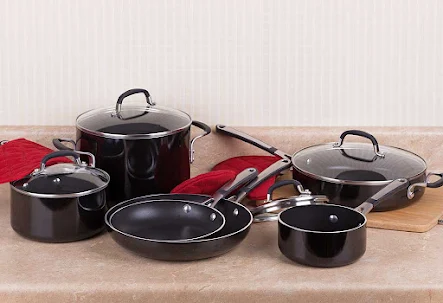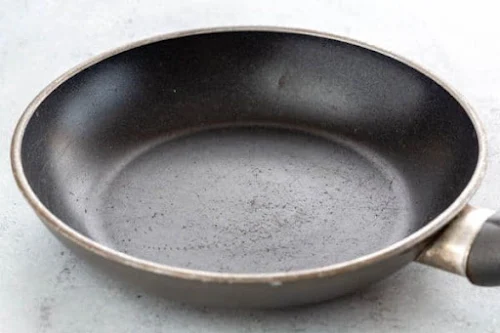Is Non-Stick Cookware Harmful to Health? This is All You Need to Know About Non-StiCK COOKWARE?
But there’s controversy around nonstick coatings, such as Teflon.
Some sources claim they’re harmful and linked to health conditions such as cancer, while others insist that cooking with nonstick cookware is completely safe.
This article takes a detailed look at nonstick cookware, its health effects, and whether or not it is safe to cook with.
What is nonstick cookware?
Nonstick cookware, such as frying pans and saucepans, gets coated with a material called polytetrafluoroethylene (PTFE), commonly known as Teflon.
Teflon is a synthetic chemical made up of carbon and fluorine atoms. It was first created in the 1930s and provides a nonreactive, nonstick, and almost frictionless surface.
The nonstick surface makes Teflon-coated cookware convenient to use and easy to clean. It also requires little oil or butter, making it a healthy way to cook and fry food.
Teflon has several other applications. It is also used to make wire and cable coatings, fabric and carpet protectors, and waterproof fabrics for outdoor clothing such as raincoats (2, 3Trusted Source).
However, over the past decade, the safety of nonstick cookware has been under investigation.
The concerns have centered on a chemical called perfluorooctanoic acid (PFOA), which was previously used to produce nonstick cookware but isn’t used today.
The investigations have also looked into the risks associated with overheating Teflon.
Dangers of overheating
Generally speaking, Teflon is a safe and stable compound.
However, at temperatures above 500°F (260°C), Teflon coatings on nonstick cookware start to break down, releasing toxic chemicals into the air (13Trusted Source).
Inhaling these fumes may lead to polymer fume fever, also known as the Teflon flu.
Polymer fume fever consists of temporary, flu-like symptoms such as chills, fever, headache, and body aches. The onset occurs after 4–10 hours of exposure, and the condition usually resolves within 12–48 hours (14Trusted Source, 15Trusted Source).
A small number of case studies have also reported more serious side effects of exposure to overheated Teflon, including lung damage (15Trusted Source, 16Trusted Source, 17Trusted Source, 18Trusted Source).
However, in all of the reported cases, individuals were exposed to fumes from overcooked Teflon cookware at extreme temperatures of at least 730°F (390°C) for extended periods of at least 4 hours (15Trusted Source, 17Trusted Source, 18Trusted Source).
While the health effects of overheated Teflon may be serious, using commonsense cooking practices will help you avoid exposure.
READ ALSO: How to GIVE yourself Cancer in 5 easy steps
What Do You Know About Non-StiCK COOKWARE?
When making non-stick metal plates, materials and substances marked with PFAS are used. All these toxic vessels are characterized by the so-called “non-stick coating”, which provides the food to burn or stick to the bottom.
Recent studies show that some kinds of PFASs cause severe liver toxicity, disruption of metabolism, and immunity disorders. Also, these can cause several types of cancer (cancer of the testis and kidney cancer). It is also considered that the toxins impede the baby while it is in the uterus.
Unfortunately, these toxins are not transmitted only on the food, they are also spread in the air, drinking water, and earth and they pollute the entire environment.
What is more alarmingly is the fact that vessels heated at 1000 degrees emit the harmful agent PFIB (perfluoroisobutene). These toxins can be accumulated in the blood and can lead to chronic disease.
In order to avoid these non–stick pans, it is best to use ceramic or glass cookware. Experts say that consumers should be aware of the potential health risk when using products containing perfluorooctanoic acid.
Tips to minimize your risk when cooking
If you follow basic safety precautions, cooking with nonstick cookware is safe, healthy, and convenient.
You can minimize your risk when cooking by following these tips:
- Don’t preheat an empty pan. Empty pans can reach high temperatures within minutes, potentially causing the release of polymer fumes. Make sure you have some food or liquid in pots and pans before you preheat.
- Avoid cooking on high heat. Cook on medium or low heat and avoid broiling, since this cooking technique requires temperatures above those recommended for nonstick cookware.
- Ventilate your kitchen. When you’re cooking, turn on your exhaust fan or open up windows to help clear any fumes.
- Use wooden, silicone, or plastic utensils. Metal utensils can lead to scuffs and scratches on the nonstick surface, reducing the life of your cookware.
- Hand washes. Gently wash pots and pans with a sponge and soapy, warm water. Avoid using steel wool or scouring pads, since they can scratch the surface.
- Replace old cookware. When Teflon coatings start to visibly deteriorate with excessive scratches, peeling, flaking, and chipping, they are ready to be replaced.












.jpeg)